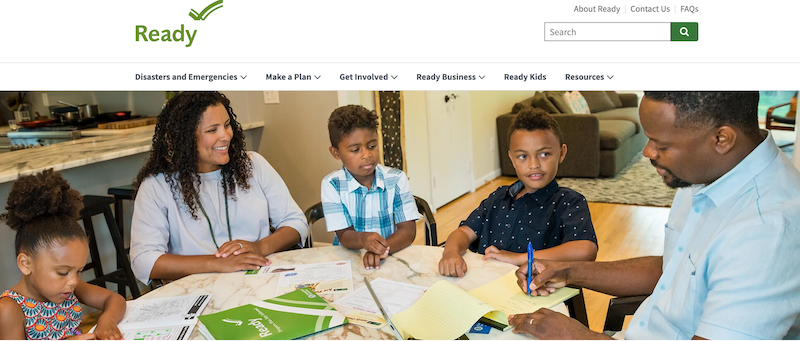If you puzzled over those emergency flares in a holiday stocking, they probably came from me. That friend nagging you about a go-bag for your trunk or slapping “pet inside” stickers on your front door? Also me. The coworker who thinks that lunch-and-learn is a good time to run through earthquake prep? Yeah, sorry about that.
I’m a trained citizen responder. Licensed HAM radio operator. Founder of an emergency mapping project recognized by the United Nations. The thing is, disaster burnout has hit even me big time.
Like a lot of things in 2020, that timing is bad: Fall is peak season for disaster professionals and well-meaning Cassandras alike. After National Preparedness Month (NPM), it’s time for the Great Shakeout and the UN’s International Day for Disaster Risk Reduction and events like the Understanding Risk Forum.
It’s easy to spot the disconnect. This year, the ready.gov homepage features a family, smiling, the kitchen table festooned with helpful worksheets. They all sport a faint, healthy sheen — no trace of maskne here. “As our nation continues to respond to COVID-19, there is no better time to be involved.” Can we agree that’s dead wrong?

Enough with the prepper heroes, already
The usual slogans now sound more aspirational than practical: “Be prepared, not scared” was the cheerful cry from NPM a few years back. If we’ve learned anything from the pandemic, it’s that none of us were prepared. And we’re all terrified.
For starters, your basic disaster training manual covers the following:
Earthquakes. Check. Wildfires. Check. Extreme heat. Check. Terrorism. Check.
Usually, though, you’re expected to face down just one event at a time. Now, emergencies are weekly threats. Take California: there’s been extreme heat, rolling blackouts, fire tornadoes and air quality similar to New Delhi. And it’s not just one state: Experts also predict an “extremely active” hurricane and tropical storm season with a record number of events in the Atlantic basin.
Layer that over a pandemic, which gums up standard safety valves such as cooling centers and community shelters, and paralysis is not only understandable, but should be expected. Right now planning feels largely irrelevant.
What follows are some ideas for those of us who aren’t anywhere near the front lines, but who must face the fracas in the coming months just the same.
Slash your news diet
This is coming from a journalist: News fasting helps.
Sign up for your city or county emergency alerts, cut everything else back to daily newsletter roundups from bedrock sources like the New York Times or Reuters. If you skew a bit more meta, Muck Rack’s daily gathers what news stories journalists are buzzing about. (These are often in the form of razor-sharp tweets! But you don’t have to read them, real time, on Twitter along with the rest of the non-essential avalanche.)
Pack a digital go-bag
Create your digital go-bag by making a dashboard for your weather and local alerts and maps. What you leave out may be just as important: If Twitter, Facebook or NextDoor are the fastest way to find out about emergencies close enough to singe your eyebrows, keep them on your phone. If not: Delete the apps on your mobile device and watch your anxiety level shrink back to seven from 11. If you can’t get yourself to delete them, experiment with pushing them to the far, unused scrolldowns of your home screen and mute alerts.
Unlike an actual diet, you’ll probably find these restrictions restore a sense of control minus the urge to binge.

Beauty’s where you find it, and you need to find it
Listicles are not my jam. Obvious advice makes my jaw grind. So I’ll skip the usual burnout bromides on sleep hygiene, relaxation, diet, exercise etc. You’ve heard it.
What’s particular to disaster fatigue right now? Outside. It’s harder to know how, where and when to get out of your pandemic-fogged head and into the wider world. Dodging a trail of unmasked, huffing joggers ratchets up the anxiety instead of relieving it. The gym is out, so is church, choir, your Meetup group, a restaurant meal.
You still need to find something that provides a look beyond your four, worry-filled walls. Go high with a bird cam, or down deep into an aquarium. Maybe you dig out the binoculars. What about a star-viewing app or virtual telescope? It could also be your nephew telling knock-knock jokes over Zoom. And make it a daily priority.
Taking stock
There is some good news – often repeated in emergency preparation workshops when people start to itch with panic – many will find that their pantries and garages already contain a lot of what they need. You can source the rest of it from dollar stores and wherever else you’re in the habit of emerging victorious with precious items like Clorox wipes.
If you’ve got some drive left, you might as well get ready. Before a routine grocery run requires elbow sharpening, revisit the pantry. Refill all your prescriptions. Tuck away a stash of small bills. Photocopy or save to a USB drive passports and home-related documents. Knock yourself out.
Me? I’ll be following the best advice from CERT training: Only stock your emergency supplies with things the people you live with actually want to eat and drink. Pretending you’re astronauts won’t get you through this. Add things to pass the time that don’t require electricity. Board games. Easy to play instruments. A pack of cards.
Safe to say, then, you’ll find me mixing up a pitcher of quarantinis and rustling the Scrabble tiles.
Cover photo: Matthew Henry on Unsplash

2 thoughts on “Disaster fatigue is real: Here’s how we fight it”